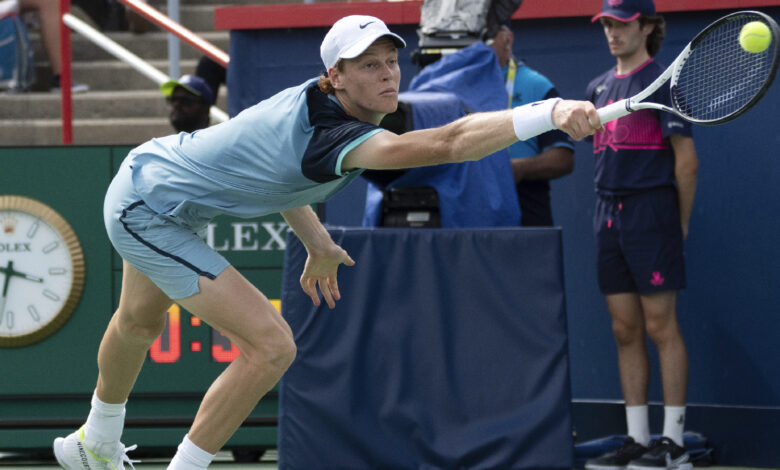Explained: Why Jannik Sinner’s ban for doping was swiftly overruled International Tennis Integrity Agency | Tennis News

On Tuesday, mere hours after he lifted the title at the Cincinnati Masters to announce himself as one of the favourites for the US Open, news emerged that Jannik Sinner, the 23-year-old World No. 1 from Italy, had failed two dope tests in March. And that Sinner had avoided a ban claiming it was a result of contamination.It is a case that nobody knew before Tuesday, and now dominates the narrative around the top of the sport.
What has Jannik Sinner tested positive for?
An in-competition test at the Masters 1000 tournament in Indian Wells, in which Jannik Sinner lost in the semifinal, conducted the International Tennis Integrity Agency (ITIA) on March 10, 2024 found an ‘adverse analytical finding’ (AAF) for Clostebol, a banned anabolic steroid. A second test, that took place out of competition on March 18 also detected the substance.
The first test recorded at 76pg (picograms) per millilitre of the sample collected while the second was recorded at 86pg per millilitre. Since one picogram is equal to one trillionth of a gram, roughly less than a billionth of a gram of the substance was found in his bloodstream.
In tennis, testing positive for non-specified substances on the World Anti-Doping Agency (WADA) l, like Clostebol, carries a mandatory provisional suspension. The benchmark sanction, per the ITIA’s decision, is a four-year suspension.
How did Jannik Sinner escape the ban?
Per ITIA rules, athletes are allowed to immediately appeal the provisional suspensions after being notified of the violation, and the suspension can be removed if the player is able to prove that the violation took place due to a contaminated product.
The Italian was suspended from April 4 to April 5, days after winning the Miami Masters, and also between April 17 and April 20, shortly after he was knocked out of the semifinal of the Monte Carlo Masters and a week before he played his next tournament in Madrid. Both times, his suspensions were revoked after his appeals were successful.
His argument was that his fitness trainer, Umberto Ferrara purchased Trofodermin, an over-the-counter spray that contains Clostebol used to heal cuts after his physiotherap, Giacomo Naldi, cut his finger on a scalpel on March 3.
Naldi used Trofodermin each morning between March 5 to March 13 on his finger and, in that time, massaged Jannik Sinner and bandaged his feet. Jannik Sinner argued that due to suffering a skin condition called psoriasiform dermatitis on his feet and back, his itchy skin often leads to small cuts and sores. The treatment adminered on Jannik Sinner his physio led to accidental contamination, and the World No. 1 maintained he had no idea about Ferrara’s possession of Trofodermin, or Naldi’s use of it.
The ITIA accepted his arguments to lift the provisional suspensions, and later, an independent tribunal appointed Sport Resolutions, a company that oversees doping cases, found that he bore “no fault or negligence” for the two violations of the Tennis Anti-Doping Program (TADP) on August 15. According to the ITIA, three scientific experts confirmed that Jannik Sinner’s explanations were plausible.
What is Clostebol?
Clostebol is an anabolic steroid that can help build muscle mass and fast-track recovery, allowing athletes to train harder. It was once part of the East Germany-sponsored doping regimen in the late 1960s and 70s.
While being banned in most countries, it is still prevalent in Italy in over-the-counter medications like Trofodermin. According to a report honestsport.com, half the world’s Clostebol cases, including tennis players, come from Italy.
Was there preferential treatment given to Jannik Sinner?
While cases of accidental contamination have happened in the past, the swiftness with which Jannik Sinner has been cleared has prompted suggestions of double standards from other players and experts on social media, including the likes of Denis Shapovalov, Nick Kyrgios, and John McEnroe.
“I guess only the top players’ images matter. I guess only the independent tribunal’s opinion on the top players is taken as sound and right,” British player Tara Moore said.
The significantly lower-ranked Moore has only just got her career back on track after being provisionally suspended for a failed dope test for 19 months, after which the ITIA found that it was also a case of accidental contamination and said she bore “no fault or negligence.”
The ITIA had sought a six-year ban for two-time Grand Slam champion Simona Halep after finding traces of roxadustat in her sample after a first-round loss at the 2022 US Open. Halep successfully appealed to the Court of Arbitration for Sport (CAS) that the failed test was a result of contamination after consuming a tainted supplement provided to her her coaching staff. CAS retrospectively reduced her ban to nine months.
These cases are in stark contrast to Jannik Sinner’s. The Italian’s explanations were easily accepted for both suspensions, and his failed tests were not made public until he was exonerated — both well within the rules but privileges not afforded to all players, perhaps thanks to the best legal advice money can buy.
The two short-lived suspensions also came during rare off-weeks in what is a packed ATP Tour calendar.
Was Jannik Sinner sanctioned in any way?
Despite exoneration, Jannik Sinner has been docked the 400 ranking points and the $325,000 of prize money he earned during the Indian Wells tournament.
The final ruling from the panel accepted ITIA can only be overruled appeal from WADA or the Italian Anti-Doping agency.



